Rank on Google's first page in 3 months
On-Page SEO: 7 Important Factors You Need to Know
May 10, 2024 | Athira K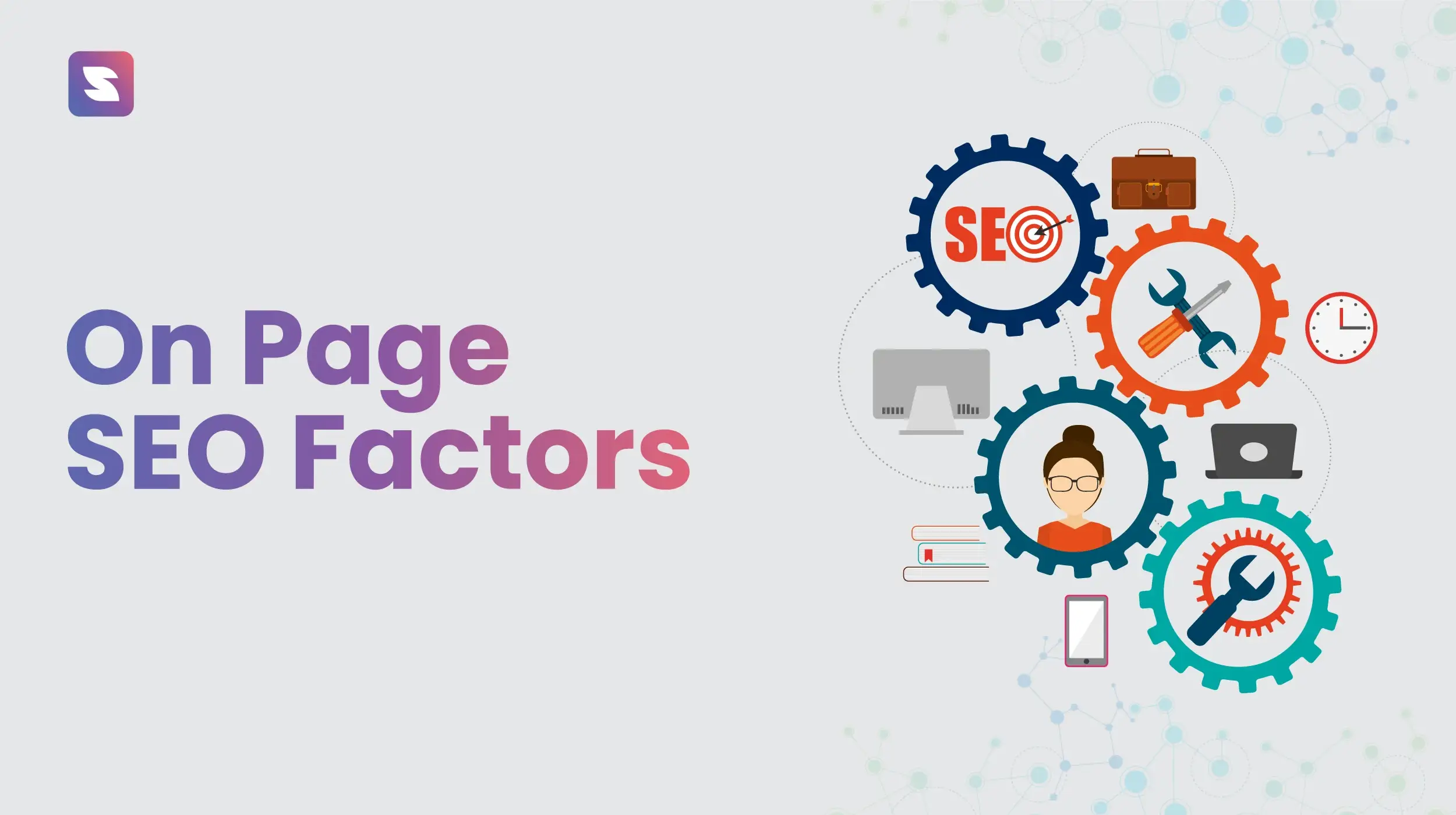
The process of on-page SEO is capable of bringing countless new visitors and customers to your website. This means that you should always give importance to the important factors in on-page SEO. All these factors will assist you in understanding the subject matter of your page and in displaying it to as many people as possible.
In this guide, you will learn the top 7 factors in an on-page SEO checklist that will help you rank higher in search engines.
What is On-Page SEO
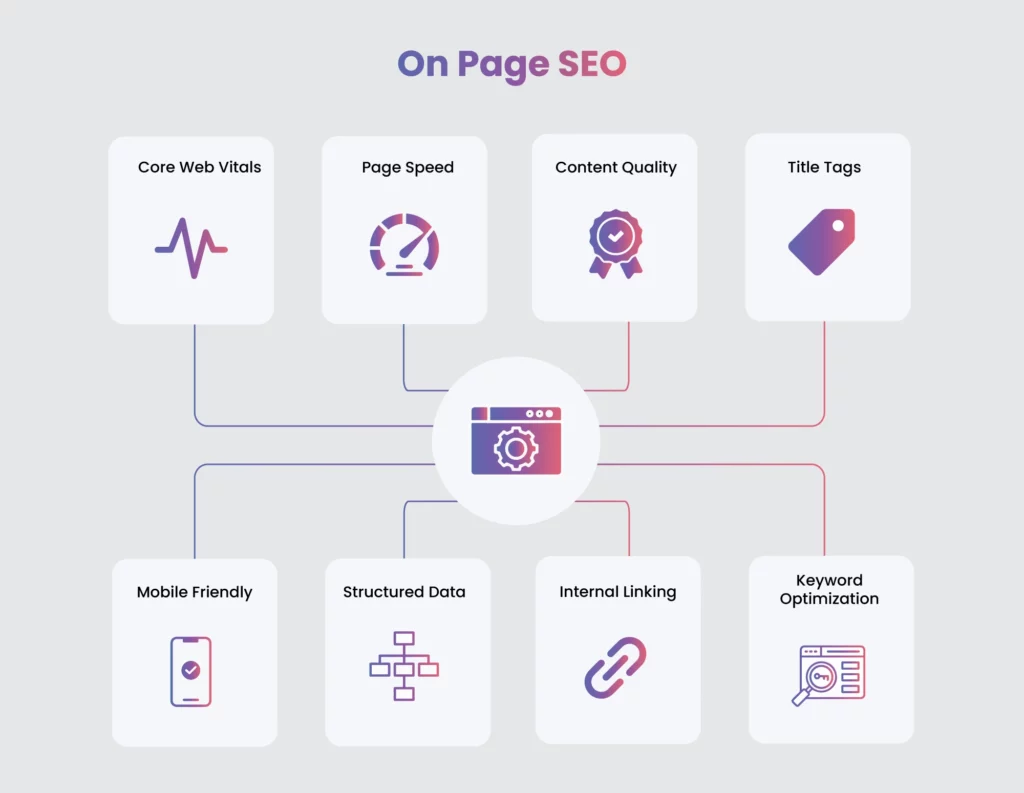
On-page SEO is a strategy that aims to improve website traffic through proper optimization techniques. This includes optimizing a page’s HTML, internal links and meta description, meta title, and keyword density and uploading high-quality, images and relevant content. As we combine all these factors in an on-page seo checklist, we have an optimized website that comes with on-page SEO.
These are the Common On-Page SEO Factors
- Content
- Keywords
- SEO writing
- Title Tags
- Meta description
- Image optimization
- Site speed
- UI/UX Design
- URL structure
You should take into account the most important factors, which we will discuss in more detail below.
7 Important Factors of On-Page SEO
Let’s explore a detailed view of the most common factors you need to consider for your on-page SEO.
1. Core Web Vitals
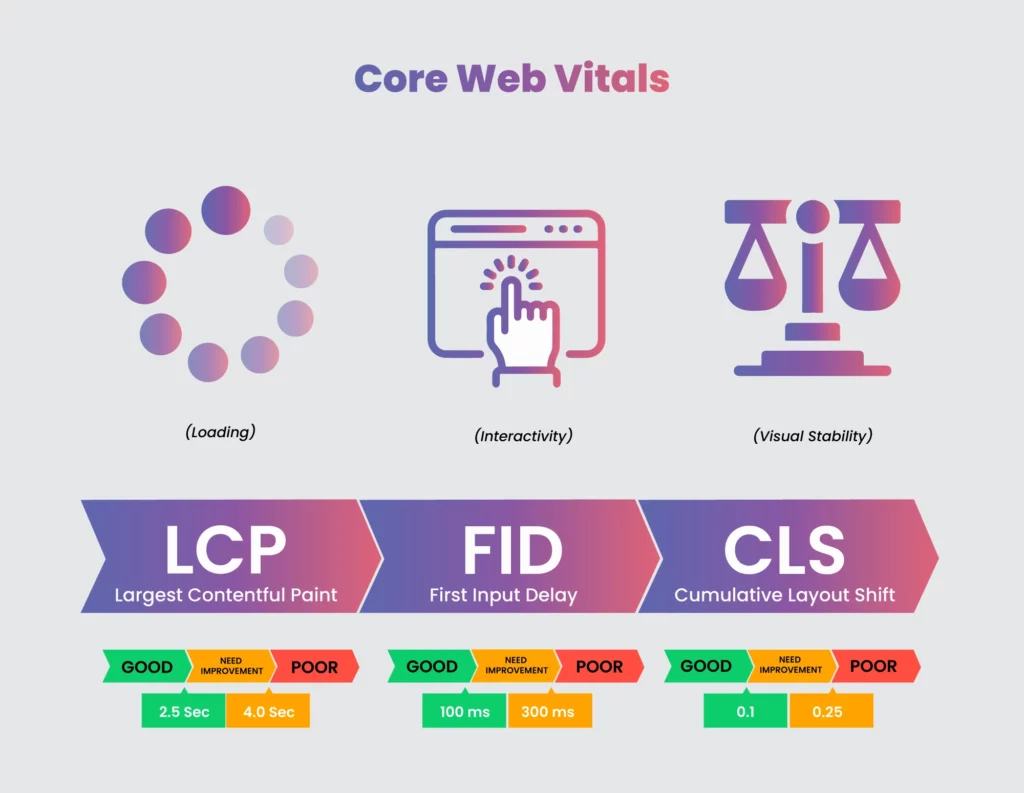
Core Web Vitals is called a set of metrics that are used to measure the user experience of a website. It is also very important in your on-page seo strategy. It helps in gaining importance with Google’s announcement that they will be factored into their search ranking algorithm.
Google introduced Core Web Vitals in 2020. This helps measure and evaluate the speed, responsiveness, and visual stability of websites. It also offers more opportunities for a ranking boost for your website.
Core Web Vitals consists of three significant metrics.
- Largest Contentful Paint (LCP): Aim for an LCP of 2.5 seconds or faster. Optimize your server, resource load times, and client-side rendering.
- First Input Delay (FID): Target an FID of 100 milliseconds or less. Minimize JavaScript execution and prioritize interaction readiness.
- Cumulative Layout Shift (CLS): Strive for a CLS of 0.1 or less. Ensure images and embeds have dimensions. Avoid inserting fresh content above old content unless it is in response to user interactions.
There are many benefits to Core web vitals in on-page seo:
- Helps indirect impact on rankings
- Enhanced user experience
- Improved conversion rates
- Enhanced mobile experience
- Competitive advantage
Improving Largest Contentful Paint (LCP)
- Prioritize Loading of Resources: Use the preload attribute to load the most critical resources first. This could be your main image, CSS files, or JavaScript needed for initial rendering.
- Make Files Smaller: Optimize images using compression tools and serve scaled images for the device. Decrease CSS and JS files to reduce the download time.
- Serve Files Closer to Users: Implement a Content Delivery Network. This will reduce the physical distance between your servers and the user, thereby improving load times.
- Host Resources on the Same Server: Reduce the number of different domains from which resources are loaded. This reduces DNS lookup times and can speed up the loading process.
- Use Caching: Leverage browser caching to store frequently accessed resources locally in the user’s browser, eliminating the need to download resources for repeat visits.
Improving Cumulative Layout Shift (CLS)
- Reserve Space for Images and Videos: You have to specify width and height dimensions for these elements. So that the browser can allocate the right amount of space in the document while the content is loading.
- Optimize Fonts: Use ‘font-display: swap;’ in your CSS to ensure text is visible during font loading and prevent layout shifts when fonts load.
- Use Animations that Don’t Trigger Layout Changes: Prefer transformations and opacity changes for animations instead of changes that affect layout, such as width, height, or top/left positioning.
- Ensure Pages Are Eligible for Cache: Browser Forward and Back (of cache) can load pages instantly from a cache when a user navigates by using the browser’s back and forward buttons.
Improving First Input Delay (FID)
- Reduce the Amount of JavaScript: Simplify your JavaScript or break up large JavaScript files into smaller, more manageable chunks. The less JavaScript the browser has to load and parse, the quicker it can respond to user interactions.
- Load JavaScript Later: Utilize the async or defer attributes to delay the loading of less critical JavaScript until after the initial render. Alternatively, think about loading scripts when users interact with the page for improved performance.
- Break Up Long Tasks: Split up long-running JavaScript into smaller tasks with idle callbacks to avoid blocking the main thread.
- Use Web Workers: For processing that doesn’t affect the DOM, move operations off the main thread entirely with Web Workers.
- Use Prerendering or Server-Side Rendering (SSR): To boost the time to the first byte and reduce the client-side JavaScript needed for the initial render, create HTML on the server, and send the fully rendered page to the client.
The importance of Core Web Vitals in on-page SEO lies in their ability to quantify and improve the user experience. By focusing on these metrics, businesses can create websites that are not only more enjoyable and functional for users but also rank better in search results.
2. Content in On-Page SEO
The importance of quality content in on-page SEO cannot be overstated. Content is fundamentally what users are searching for on the web, and it serves as the foundation upon which other elements of SEO build.
Engaging and well-structured content contributes to a website’s visibility and ranking in search engine results. Google’s algorithms increasingly prioritize content relevance, quality, and value to the users.
Key Points:
- Content must be closely aligned with potential search queries, incorporating relevant keywords naturally within the text.
- Content that is original, informative, and well-written tends to rank higher.
- Search engines favor unique content that provides value to users, potentially reducing bounce rates and increasing the average time spent on the page.
- High-quality content tends to engage users more effectively, encouraging them to interact with the page through comments, shares, and other actions.
- Ensure content addresses user queries comprehensively and adds unique insights beyond what’s widely available.
- Regularly update content to maintain accuracy and freshness.
- Use clear headings and structured sections to enhance readability and facilitate quick understanding.
It’s important to remember these key factors if you are going to focus on on-page SEO factors related to content.
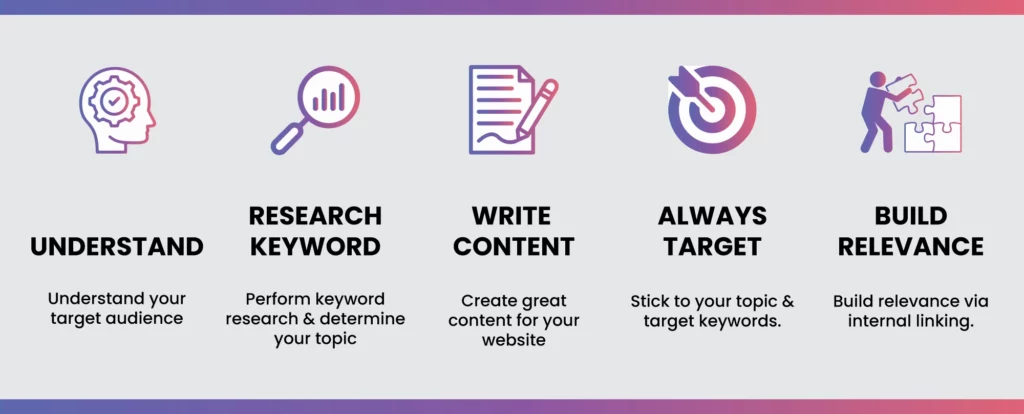
- Understand your target audience:
Before creating content, it’s crucial to know who will be reading it. Understanding your target audience involves recognizing their needs, preferences, and pain points. This knowledge enables you to tailor your specific content to speak directly to audience interests and challenges. That also helps increase engagement and relevance.
- Perform keyword research & determine your topic:
Keyword research is a foundational task for page SEO. It involves identifying phrases people enter into search engines related to your products, services, or general topics. This keyword research assists you in understanding what your audience is searching for. Determining your topic based on this research ensures your content is focused and meets your audience’s demands.
- Create great content:
The quality of your content is the factor. Great content is informative, engaging, and well-structured, providing value to your readers. It should be original, accurate, and insightful. It has to encourage the target audience to stay on your site longer and interact with your brand. Good and quality content also helps establish your authority and expertise in the field.
- Stick to your topic & target keywords:
Consistency is key in SEO. Once you have established a topic, make sure your content consistently aligns with it and uses your target keywords appropriately. Maintaining this consistency aids search engines in comprehending the relevance of your content to queries, ultimately enhancing your visibility in search results.
- Build relevance via internal linking:
Internal linking involves linking to other pages on your website within your content. This practice helps search engines understand the structure of your website and the relevance of web pages in relation to one another. It also keeps visitors engaged longer as they navigate through additional relevant content on your site.
3. Keyword Optimization in On-Page SEO
Keyword optimization is an essential strategy in on-page SEO. It involves the strategic incorporation of relevant keywords into a website’s content and meta tags. This practice helps search engines understand the subject matter of your content, thereby matching it more accurately to user queries. For effective keyword optimization, conduct thorough keyword research to identify terms and phrases that your target audience is searching for.
Once identified, these keywords should be naturally integrated into various elements of your webpage, including the title tag, meta description, headings, and throughout the body text. However, it’s important to avoid keyword stuffing and make proper keyword mapping.
Overloading your content with too many keywords can negatively impact your site’s readability and result in search engine penalties. Focus on creating user-friendly content that provides real value, with keywords enhancing rather than detracting from the quality and relevance of your information.
- Perform thorough keyword research to identify primary and secondary keywords that are relevant to your content.
- Include keywords naturally in the title, meta description, headers, and throughout the content.
- Use latent semantic indexing (LSI) keywords to help search engines understand content context and nuances.
- Use relevant keywords naturally in the title, headings, and throughout the content.
- Avoid overstuffing keywords, as this can impact readability and potentially lead to penalties from search engines.
- Conduct thorough keyword research to identify high-volume and low-competition keywords to target in your content.
You can easily use a keyword research tool for keyword optimization. You can just enter the targeted keyword into the tools, and it gives you all the insights about the keyword and related keywords for that. You can easily categorize that as per your preference of keywords.
Also Read: Best Keyword Research Tools for SEO
4. Internal Linking in On-Page SEO
Internal links are important in SEO as they link from one page of the website to another page. Users will click on these links to roam around your website to find the content they want. There are two types of important linking: ‘internal linking’ and ‘external linking.’ Internal links are used to connect pages and posts on your website, and external links help connect your pages to other websites.
Google will follow these links to discover content on a website, so it is a necessary step in on-page seo factors.
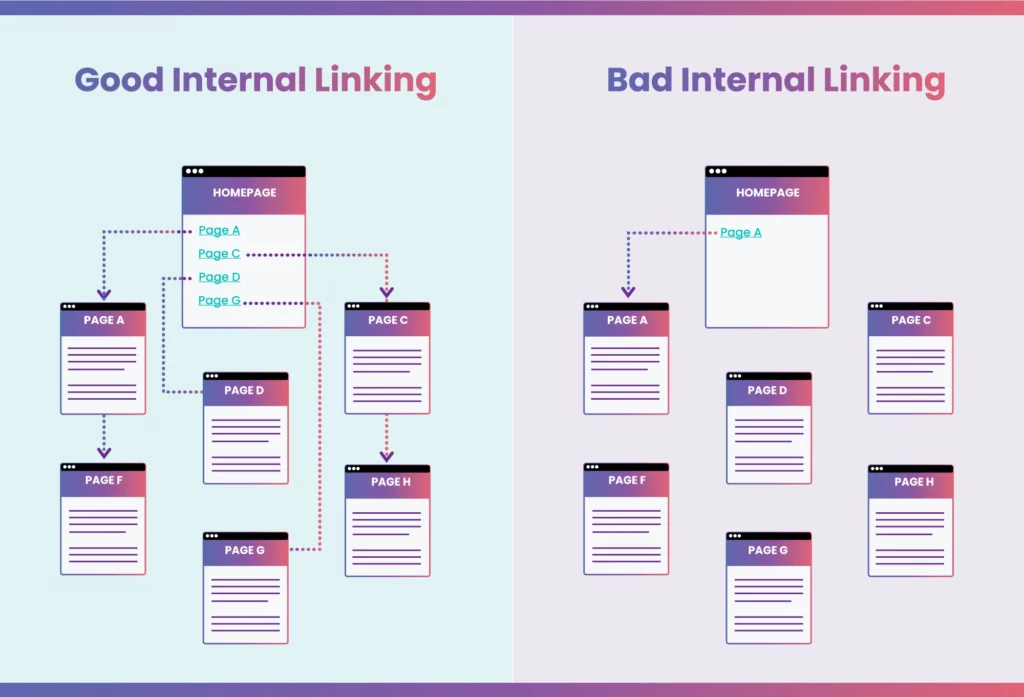
There are many benefits of internal linking;
- it helps in establishing relationships between content
- helps search engines to understand your site structure
- helps search engines better find your content
Here’s a straightforward step-by-step guide to help you set up an effective internal linking strategy:
- Identify Your Site’s Pillar Pages
Pillar pages are the core of your website’s content architecture. These are comprehensive pages that broadly cover a particular topic and are linked to various related content. Identifying these allows you to structure your website more effectively. Pillar pages should answer fundamental questions related to your primary topics and will serve as the main hubs of traffic.
- Create Topic Clusters Using Internal Links
Once pillar pages are established, the next step is to create topic clusters. These are groups of related articles or pages that provide detailed information about different aspects of the main topic on the pillar page. Link these web pages back to the pillar page using precise, keyword-rich anchor texts. This not only helps establish a semantic relationship between the pages but also improves the SEO strength of the pillar pages.
- Choose the Proper Anchor Text
Anchor text is called the clickable text in a hyperlink. SEO best practices suggest that the anchor text should be relevant to the web page you’re linking to. This proper anchor text choice will assist search engines in knowing the content of the destination page. Avoid using generic text like “click here” as it does not provide information about what the link is about. Instead, use descriptive keywords that reflect the content of the target page.
- Identify Your Site’s Authority Pages
Authority pages are those that have gained recognition and trust from the audience and search engines alike. These pages typically have high-quality content and garner a lot of inbound links. Identifying these can help you leverage their authority to boost lower-performing pages. By linking from these authority pages to newer or less visible pages, you can distribute some of the established credibility and improve their visibility.
- Support Your New Pages
For new pages to gain visibility, they need to be supported through internal links from established pages. This not only helps search engines index the new pages quicker but also drives traffic from other parts of your site to them. Make sure that these links are contextual and that the linked pages offer relevant and valuable information to your visitors.
5. Mobile Optimization
63% of organic search visits now come from mobile devices. Optimizing your site for mobile is crucial for boosting its ranking in relevant search engine results on mobile devices. It helps to give mobile users a better experience. And people are using mobile phones a lot these days so it’s essential.
You can set your website for mobile SEO, which comes with three major options;
- Responsive Design:
Responsive design is aimed at creating websites with Responsive design. It aims to create websites that offer an excellent viewing experience across different devices, like desktops and mobile phones, by adjusting their layout dynamically. This ensures easy reading and navigation without the need for excessive resizing, panning, or scrolling.
This is achieved through flexible layouts, CSS media queries, and sometimes JavaScript that reacts to the user’s environment. Responsive design is Google’s recommended design pattern because it does not require redirection, simplifies the sharing and linking of content, and helps maintain a consistent user experience across devices.
- Dynamic Serving:
Dynamic serving generates different HTML and CSS for other devices using the same URL. This means that the server sends different codes to various devices from the same URL. It then optimizes the user experience specifically for that type of device.
To implement dynamic serving correctly, sites need to indicate to search engines that their content serves dynamically by using the Vary HTTP header. This approach is more complex than responsive design because it requires the server to accurately detect the type of device accessing the site and serve the correct version.
- Separate URLs:
Some websites opt for a mobile-specific strategy, serving different content on separate URLs depending on the device used.
For example, a mobile user might be directed to “m.example.com,” while desktop users continue to access “www.example.com.”
This method requires careful configuration to avoid SEO pitfalls such as duplicate content issues. Each URL needs to be linked with alternate and canonical tags. That will help search engines understand the relationship between the content versions. While this approach offers the flexibility to tailor content specifically for mobile users, it can be resource-intensive to maintain parallel versions of a site.
6. Structured Data
Structured data is a standardized format used to provide details about a page and classify its content. Implementing structured data is a key strategy for boosting SEO efforts and improving your site’s visibility in SERPs.
Here are detailed tips on how to effectively use structured data on your website.
- Use schema.org Markup:
Schema.org is a collaborative, community-driven platform endorsed by all search engines. Its purpose is to develop, maintain, and advocate for schemas that standardize structured data on the Internet. By applying schema.org vocabulary to elements on your website, you streamline the process for search engines to understand your page content. This helps them grasp how each component relates to other pieces of data.
Proper implementation of schema markup enhances the display of your page in SERPs. And they potentially increase the click-through rates with rich snippets that include star ratings, author photos, or publication dates.
How to Implement: You can add schema markup to your HTML code. Common types of schema include those for articles, local businesses, restaurants, book reviews, and events.
- Test Your Structured Data with Google’s Rich Results Test:
Once you have implemented your structured data, it’s important to ensure that it is working correctly. Google’s Rich Results Test tool can verify that your pages are eligible for rich results, allowing you to see how your pages might look in the search results. This testing helps you diagnose and fix issues, ensuring that your structured data is set up correctly to maximize its efficacy in enhancing your SEO.
How to Implement: Enter the URL of the page or paste the HTML code of your page into the tool. It will check for any errors or suggestions for your structured data.
- Stay Updated with New Features and Types of Structured Data:
The world of SEO is constantly evolving, as are the capabilities of structured data. Staying informed about new types of structured data and features can provide new opportunities for your SEO strategy. Using new types of structured data as they become supported by search engines can keep your site at the cutting edge of SEO. They can potentially put you ahead of competitors and make your site more valuable and visible to users.
How to Implement: Regularly check the schema.org website and subscribe to SEO newsletters that update on changes and new features in the world of structured data and Google’s search updates.
7. Proper Image Optimization
Images are a primary factor in on-page seo. They are the things that help readers to get engaged with a page and also a ranking factor. You have to optimize all the images so that you will get the best results.
- Image Resize: Don’t let the fear of large file sizes slow down your page loading times and negatively impact your SEO. With proper tools or image editing software, you have to resize images to maintain quality. You can compress images without significant quality loss, ensuring a smooth user experience.
- Add Alt Text: Alt text, or alternative text, is a brief description that helps search engines understand what an image represents. It also improves accessibility for visually impaired users. Include relevant keywords naturally in the alt text to enhance the SEO value while accurately describing the image content.
- Stick to the Concept: Each image should align with the article’s overall concept. Avoid including generic or unrelated visuals, as it can confuse readers and dilute your message. Cohesive images complement and reinforce the textual content, making the page more engaging.
- Don’t Replace Text with Images: While visuals are powerful, avoid replacing essential text with images, as search engines can’t interpret them like written content. Instead, use images to support or illustrate points made in the text.
- Proper Filename: Use descriptive filenames for images before uploading them to your website. A meaningful filename like “on-page-seo-optimization.jpg” is more informative than a generic “IMG12345.jpg.” Descriptive filenames give search engines additional context and provide a slight SEO boost.
Best On-Page SEO Tools
1. SuiteJar
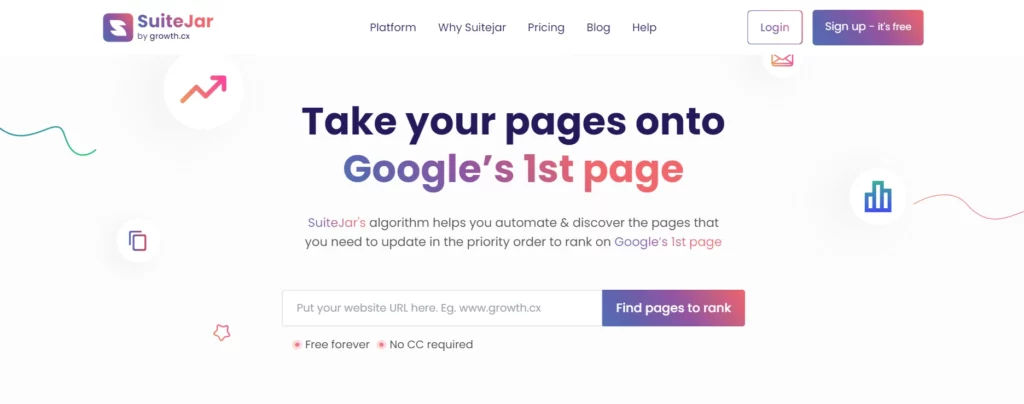
SuiteJar is a complete SEO tool that provides an in-depth analysis of your web pages. It stands out as one of the best tools for on-page search engine optimization. This on-page seo tool offers a variety of services and enables a thorough evaluation of your website. Its features include an easy web analysis, keyword planner, and website auditor that enhance your on-page SEO efforts.
Key Features
- Easy Web Analytics: It helps you understand how your website is doing. You can integrate GA4 with Suitejar, which eliminates any complexities and gives you insights. These features simplify the process of monitoring, analyzing, and taking action based on data, ultimately enhancing your website’s well-being.
- Website Auditor: The feature gives you an idea of how your site is doing against Google’s standards. It gives you insights into errors and areas for improvement so you can make the right strategy.
- Keyword Planner: This helps you find the most effective keywords for your SEO strategy. It provides a comprehensive insight into each keyword’s potential impact with metrics like keyword volume, SEO difficulty, and CPC (Cost Per Click).
2. Ahrefs
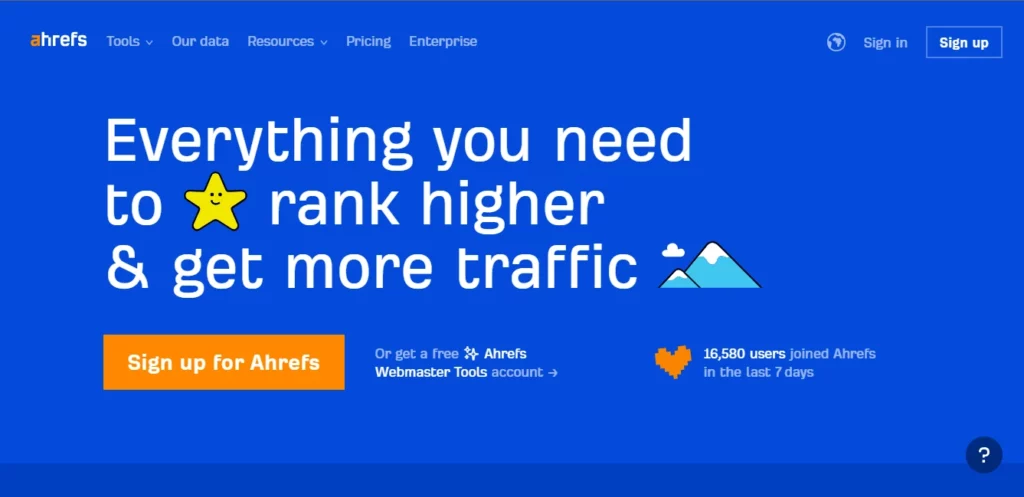
Ahrefs is a comprehensive SEO tool that specializes in backlink analysis but has significantly expanded to include on-page SEO features. It is renowned for its extensive data index and user-friendly interface. Ahrefs’ Site Audit feature crawls all the pages on your website and highlights a range of on-page issues. Their audit includes slow-loading pages, broken links, and overuse of keywords. It helps you to optimize your site’s health and SEO performance.
3. SEMrush
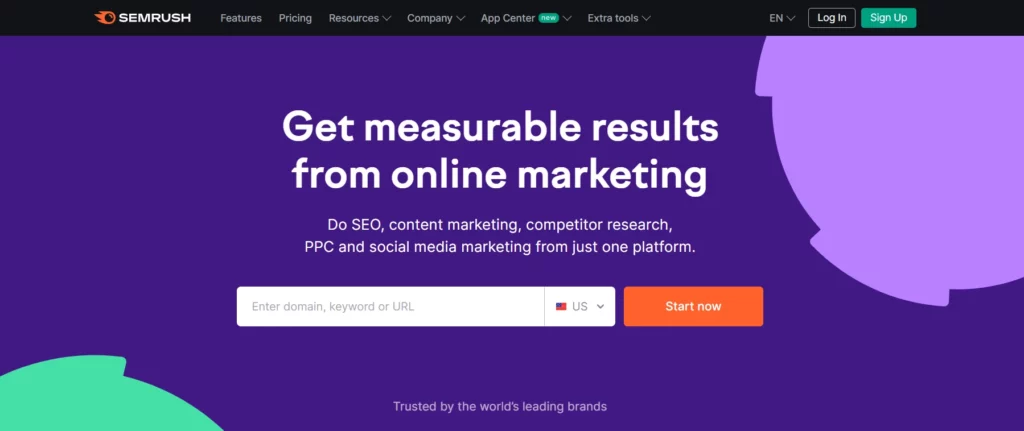
SEMrush is an all-in-one marketing toolkit that provides a wide array of functionalities, including SEO, PPC, social media, and content marketing tools. It is particularly preferred for its competitive analysis capabilities, which enable users to gain deep insights into their competitors’ strategies. SEMrush provides more extensive competitive analysis tools and broader features for integrated marketing campaigns.
Conclusion
In conclusion, on-page SEO is important to success in your website SEO. This blog has explored seven crucial factors that can significantly impact your website’s search engine visibility. By following this on-page SEO checklist, you can establish long-term SEO success in your business. Invest in an affordable SEO tool that helps you with your on-page optimization. Then, you’ll be able to improve your website’s ranking, attract organic traffic, and achieve your online goals with dedication and implementation.
FAQ
- What is on page seo?
On-page SEO is called the practice of optimizing individual website pages to improve their SEO rankings and attract organic traffic.
- How do you do on-page seo step by step?
When it comes to performing on-page SEO, you can follow these steps: conduct keyword research, optimize meta tags and headers, create high-quality content, optimize images, improve website speed, ensure mobile responsiveness, and enhance user experience.
- How to improve on page seo?
Improve on-page SEO by regularly updating and optimizing content, focusing on relevant keywords, enhancing website usability, optimizing images and multimedia, improving page loading speed, and ensuring proper formatting and structure.
4. What are on-page seo techniques?
On-page SEO techniques include keyword optimization, meta-tag optimization, content optimization, internal linking, image optimization, URL optimization, mobile optimization, schema markup implementation, and user experience optimization.
